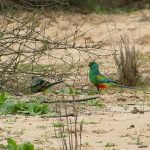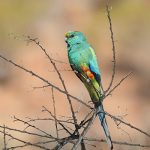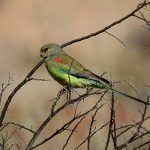MULGA PARROT
The Captivating Mulga Parrot: Jewels of Australia’s Arid Heart
Among the vast, sun-drenched woodlands and shimmering grasslands of Australia’s interior, a flash of vivid green or a streak of bright blue often signals the presence of the Mulga Parrot. These remarkable birds are not only an emblem of resilience but also a living tapestry of colour and adaptation.
Vivid Description: Sights, Sounds, and Sensations
Imagine wandering through a mulga woodland at dawn. The air is dry and cool, carrying the faint scent of eucalyptus and dust. Suddenly, a burst of movement catches your eye—a small parrot, no larger than your hand, flits between the branches.
- Male Mulga Parrot: Dressed in a dazzling array of colours—emerald green feathers shimmer in the morning light, a sapphire-blue face peers curiously from behind leaves, and a splash of golden yellow glows across the chest. A thin, bright red band stretches across the forehead, while a subtle blue band marks the nape.
- Females and Juveniles: Don similar attire, though their hues are gentler, blending softly with the muted tones of the landscape.
- Sounds: Their calls are crisp and tinkling, echoing across the open country—a cheerful chorus that brings life to even the quietest corners.
If you listen carefully, you may hear the gentle rustle of feathers as they land, or the soft click of beaks as they feed.
Adaptations to a Harsh Land
Life in Australia’s arid and semi-arid regions is not easy. Yet, the Mulga Parrot thrives in:
- Mulga woodlands
- Open shrublands
- Spinifex grasslands
These habitats, often defined by hardy acacias and spiky grasses, are dry for much of the year. Here, water is scarce and food is unpredictable. The Mulga Parrot’s secret lies in its resourcefulness:
- Diet: Their menu is broad and flexible. With a specialised brush-tipped tongue, they delicately lap up nectar and pollen from native flowers, supplementing with seeds, fruits, and the occasional insect.
- Foraging Behaviour: Watch as they hang acrobatically from branches, sometimes even upside down, expertly extracting food from the trickiest blooms.
- Social Life: Most often, you’ll see them in small flocks or family groups, weaving through trees and sharing the bounty they find.
The Cycle of Life
When winter begins to fade, and the land hints at renewal, Mulga Parrots start their breeding season—typically between August and January.
- Nesting Sites: They choose tree hollows, crevices in cliffs, or even old termite mounds as safe cradles for their young.
- Eggs and Incubation: The female lays 3 to 5 small, white eggs. Over three weeks, she keeps them warm, while the male brings food.
- Raising Chicks: After hatching, both parents feed and care for the chicks, who fledge after about five weeks—emerging into a world where survival is a daily triumph.
Conservation and Significance
| Status | Threats | Conservation Focus |
|---|---|---|
| Least Concern | Habitat loss, land clearing, livestock grazing | Habitat preservation, fire management, nest site protection |
Although Mulga Parrots are not considered threatened, their future is closely tied to the health of their fragile habitats. Clearing land for agriculture and grazing, as well as altered fire regimes, can disrupt the delicate balance they rely on.
Why They Matter
- Ecosystem Role: As pollinators and seed dispersers, Mulga Parrots help sustain the very plants they depend on.
- Symbol of Resilience: Their presence is a reminder of nature’s ability to adapt, survive, and flourish—even in the most challenging environments.
A Lasting Impression
Picture the Mulga Parrot again: a streak of green and gold against the red earth, a song carried on the dry wind, a living testament to the wonders of Australia’s wild heart. Their story is a call to cherish, protect, and marvel at the incredible diversity of life that shares our planet.
By learning about and safeguarding species like the Mulga Parrot, we ensure that these jewels of the outback continue to enrich both their landscapes and our collective imagination for generations to come.



